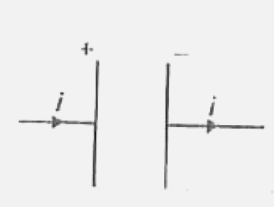A parallel - plate capacitor is being charged.Show that the displacement current across an area in the region between the plates and parallel to it is equal to the conduction current in the connecting wires.
To show that the displacement current across an area in the region between the plates of a parallel-plate capacitor is equal to the conduction current in the connecting wires, we can follow these steps:
1. Understanding the Setup:
- Consider a parallel-plate capacitor with two plates. Let the area of each plate be A and the separation between the plates be d. As the capacitor is being charged, a charge Q accumulates on the positive plate.
2. Electric Field Between the Plates:
- The electric field E between the plates of the capacitor is given by the formula:
E=QAϵ0
where ϵ0 is the permittivity of free space.
3. Electric Flux:
- The electric flux ΦE through an area A between the plates is given by:
ΦE=E⋅A=(QAϵ0)⋅A=Qϵ0
4. Displacement Current:
- The displacement current ID is defined as:
ID=ϵ0dΦEdt
- Substituting the expression for electric flux:
ID=ϵ0ddt(Qϵ0)
- Simplifying this gives:
ID=ϵ0⋅1ϵ0⋅dQdt=dQdt
5. Conduction Current:
- The conduction current IC in the connecting wires is defined as:
IC=dQdt
6. Equating Displacement Current and Conduction Current:
- From the previous steps, we have:
ID=dQdt=IC
- Therefore, we can conclude that:
ID=IC
Conclusion:
We have shown that the displacement current ID across an area between the plates of a parallel-plate capacitor is equal to the conduction current IC in the connecting wires.
- Consider a parallel-plate capacitor with two plates. Let the area of each plate be A and the separation between the plates be d. As the capacitor is being charged, a charge Q accumulates on the positive plate.
- The electric field E between the plates of the capacitor is given by the formula:
E=QAϵ0
where ϵ0 is the permittivity of free space.
- The electric flux ΦE through an area A between the plates is given by:
ΦE=E⋅A=(QAϵ0)⋅A=Qϵ0
- The displacement current ID is defined as:
ID=ϵ0dΦEdt
- Substituting the expression for electric flux:
ID=ϵ0ddt(Qϵ0)
- Simplifying this gives:
ID=ϵ0⋅1ϵ0⋅dQdt=dQdt
- The conduction current IC in the connecting wires is defined as:
IC=dQdt
- From the previous steps, we have:
ID=dQdt=IC
- Therefore, we can conclude that:
ID=IC
We have shown that the displacement current ID across an area between the plates of a parallel-plate capacitor is equal to the conduction current IC in the connecting wires.
Topper's Solved these Questions
- BOOK - HC VERMA ENGLISHCHAPTER - ELECTROMAGNETIC WAVESEXERCISE - Worked Out Examples5videos
ELECTROMAGNETIC WAVES
- BOOK - HC VERMA ENGLISHCHAPTER - ELECTROMAGNETIC WAVESEXERCISE - objective 19videos
ELECTROMAGNETIC WAVES
- BOOK - HC VERMA ENGLISHCHAPTER - ELECTROMAGNETIC INDUCTIONEXERCISE - Questions for short answer9videos
ELECTROMAGNETIC INDUCTION
- BOOK - HC VERMA ENGLISHCHAPTER - GAUSS LAWEXERCISE - Short Question7videos
GAUSS LAW
Similar Questions
Knowledge Check
- Question 1 - Select One
As the distance between the plates of a parallel plate capacitor decreased
AIf both assertion and reason are ture and reason is the correct explanation of assertion.BIf both assertin and reason are ture but reason is not the correct explanation of assertion .CIf assertion is true but reason is false.DIf both assertion and reason are false. - Question 2 - Select One
Displacement current goes through the gap between the plates of a capacitor when the charge of the capacitor
Ais changing with timeBdecreasesCdoes not changeDdecreases to zero
A parallel plate capacitor is charged and then isolated. On increasing the plate separation
View SolutionImagine a light planet revolving around a very massive star in a circular orbit of radius r with direction T. On what power of r, will the square of time period depends if the gravitational force of attraction between the planet and the star is proportional to r−5/2 .
View SolutionDisplacement current goes through the gap between the plates of a capacitor when the charge of the capacitor
View SolutionThe charging current for a capacitor is 0.25A. What is the displacement current across its plates?
View SolutionA parallel plate capacitor with circular plates of radius R is being charged as shown. At the instant shown, the displacement current in the region between the plates enclosed between R2 and R is given by
 View Solution
View SolutionA parallel plate capacitor 20 μF is being charged by a voltage source whose potential is changing at the rate of 3 V/s. The conduction current through the connecting wires, and the displacement current through the plates of the capacitor, would be, respectively:
View Solution

